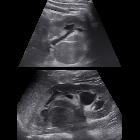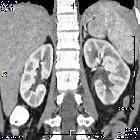Bertini-Säulen









Columns of Bertin represent the extension of renal cortical tissue which separates the pyramids, and as such are normal structures. They become of radiographic importance when they are unusually enlarged and may be mistaken for a renal mass (renal pseudotumor).
Nomenclature of such enlarged columns is a little confusing, sometimes referred to as septa (although this may also refer to normal columns). Ideally, the term hypertrophied column of Bertin or prominent column of Bertin should be used to avoid confusion.
Epidemiology
Columns of Bertin are present in ~50% of the healthy population and in 20% are bilateral. Double columns of Bertin in one kidney are less common, occurring in only 4% .
Hypertrophied columns of Bertin are more commonly bilateral, occurring in 60% .
Embryology
The kidneys are formed from the fusion of multiple lobules, each containing a central core of medullary tissue surrounded by a mantle of the cortex. Fusion of adjacent lobules leads to cortical tissue remaining between the pyramids, each column formed by the fusion of two layers of cortex . They are thus located beneath fetal lobulations (usually not visible in adults).
Radiographic features
Key to correct identification of a hypertrophied column of Bertin is the fact that it is in continuity with, and of similar appearance to, normal renal cortical parenchyma, and that the renal outline is preserved.
They are usually located in the mid-portion of the kidney and are more commonly found on the left side .
Intravenous urography
During intravenous urography, the columns of Bertin may mimic a mass by splaying and distorting the calyces. The renal outline, however, is normal (which is usually not the case when a renal cell carcinoma is present) and a slight indentation overlying the column may be seen representing the location of previous fetal lobulation.
The diagnosis can be confirmed with CT or MRI.
Ultrasound
Appearances on ultrasound can be confusing, however, in general, the echogenicity of the pseudomass is homogeneous and continuous with renal cortex. The mass has been described as "splitting" or "indenting" the renal sinus.
The diagnosis can be confirmed with CT or MRI, or more recently with contrast-enhanced sonography, demonstrating similar enhancement as the normal cortex.
CT and MRI
CT and MRI can definitively demonstrate the hypertrophied column to have imaging features identical to that of the adjacent normal cortex.
On non-contrast CT they appear isodense to normal parenchyma and, following administration of contrast, enhance uniformly with renal cortex, and remain isodense to normal parenchyma on delayed images.
Similarly on MRI they appear isointense to cortex on all sequences and enhance similarly .
History and etymology
It is named after Exupere Joseph Bertin (1712-1781), a French anatomist who initially described such morphology in renal anatomy in 1744 .
Differential diagnosis
The differential is essentially that of all renal masses and renal pseudotumors, and includes:
- renal cell carcinoma (RCC)
- usually distorts renal outline
- altered vascularity or enhancement
- transitional cell carcinoma of the renal pelvis
- usually irregular and infiltrating
- enhances less vividly than cortex on CT and MRI
- renal sinus cyst
- does not enhance during nephrogenic phase
- no internal echoes or vascularity
- duplex collecting system with a cortical septum
Siehe auch:
- Nierenzellkarzinom
- parapelvine Nierenzysten
- Doppelniere
- Transitionalzellkarzinom des Nierenbeckens
- Pseudotumor der Niere
- Raumforderungen der Niere
und weiter:

 Assoziationen und Differentialdiagnosen zu Bertini-Säulen:
Assoziationen und Differentialdiagnosen zu Bertini-Säulen:





